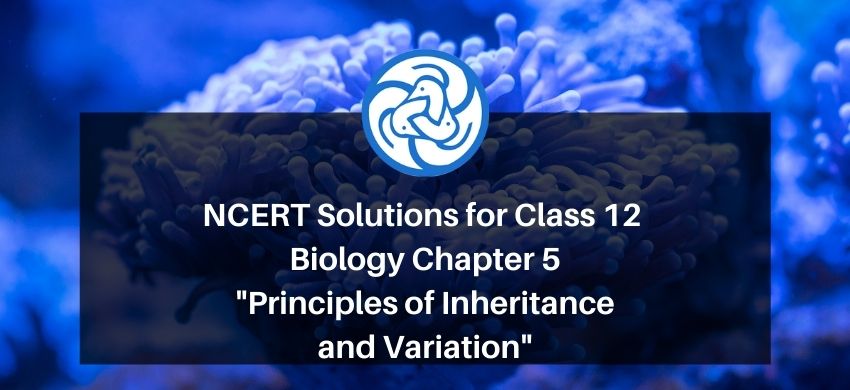
NCERT Solutions for Class 12 Biology Chapter 5 Principles of Inheritance and Variation PDF
Hey, are you a class 12 student and looking for ways to download NCERT Solutions for Class 12 Biology Chapter 5 Principles of Inheritance and Variation PDF? If yes. Then read this post till the end.In this article, we have listed NCERT Solutions for Class 12 Biology Chapter 5 Principles of Inheritance and Variation in PDF that are prepared by Kota’s top IITian Faculties by keeping Simplicity in mind.
If you want to learn and understand class 12 Biology Chapter 5 "Principles of Inheritance and Variation" in an easy way then you can use these solutions PDF.
NCERT Solutions helps students to Practice important concepts of subjects easily. Class 12 Biology solutions provide detailed explanations of all the NCERT questions that students can use to clear their doubts instantly.
If you want to score high in your class 12 Biology Exam then it is very important for you to have a good knowledge of all the important topics, so to learn and practice those topics you can use eSaral NCERT Solutions.
In this article, we have listed NCERT Solutions for Class 12 Biology Chapter 5 Principles of Inheritance and Variation PDF that you can download to start your preparations anytime.
So, without wasting more time Let’s start.
Question 1: Mention the advantages of selecting pea plant for experiment by Mendel.
Solution. Mendel selected pea plants to carry out his study on the inheritance of characters from parents to offspring.
He selected a pea plant because of the following features.
(a) Peas have many visible contrasting characters such as tall/dwarf plants, round/wrinkled seeds, green/yellow pod, purple/white flowers, etc.
(b) Peas have bisexual flowers and therefore undergo self pollination easily. Thus, pea plants produce offsprings with same traits generation after generation.
(c) In pea plants, cross pollination can be easily achieved by emasculation in which the stamen of the flower is removed without affecting the pistil.
(d) Pea plants have a short life span and produce many seeds in one generation.
Question 2: Differentiate between the following −
(a) Dominance and Recessive
(b) Homozygous and Heterozygous
(c) Monohybrid and Dihybrid.
Solution. (a) Dominance and Recessive

(b) Homozygous and Heterozygous

(c) Monohybrid and Dihybrid

Question 3: A diploid organism is heterozygous for 4 loci, how many types of gametes can be produced? Solution. Locus is a fixed position on a chromosome, which is occupied by a single or more genes. Heterozygous organisms contain different alleles for an allelic pair. Hence, a diploid organism, which is heterozygous at four loci, will have four different contrasting characters at four different loci.
For example, if an organism is heterozygous at four loci with four characters, say Aa, Bb, Cc, Dd, then during meiosis, it will segregate to form 8 separate gametes.
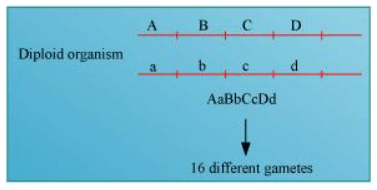
If the genes are not linked, then the diploid organism will produce 16 different gametes. However, if the genes are linked, the gametes will reduce their number as the genes might be linked and the linked genes will be inherited together during the process of meiosis.
Question 4: Explain the Law of Dominance using a monohybrid cross.
Solution. Mendel's law of dominance states that a dominant allele expresses itself in a monohybrid cross and suppresses the expression of recessive allele. However, this recessive allele for a character is not lost and remains hidden or masked in the progenies of $F_{1}$ generation and reappears in the next generation
For example, when pea plants with round seeds (RR) are crossed with plants with wrinkled seeds (rr), all seeds in $\mathrm{F}_{1}$ generation were found to be round (Rr). When these round seeds were self fertilized, both the round and wrinkled seeds appeared in $\mathrm{F}_{2}$ generation in $3: 1$ ratio. Hence, in $\mathrm{F}_{1}$ generation, the dominant character (round seeds) appeared and the recessive character (wrinkled seeds) got suppressed, which reappeared in $\mathrm{F}_{2}$ generation.
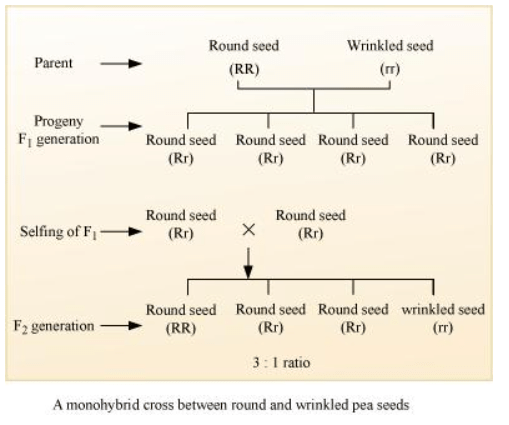
Question 5: Define and design a test - cross?
Solution. Test cross is a cross between an organism with unknown genotype and a recessive parent. It is used to determine whether the individual is homozygous or heterozygous for a trait.
If the progenies produced by a test cross show $50 \%$ dominant trait and $50 \%$ recessive trait, then the unknown individual is heterozygous for a trait. On the other hand, if the progeny produced shows dominant trait, then the unknown individual is homozygous for a trait.
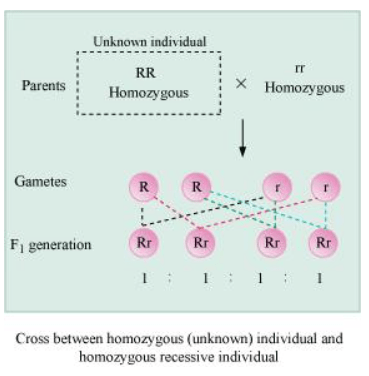
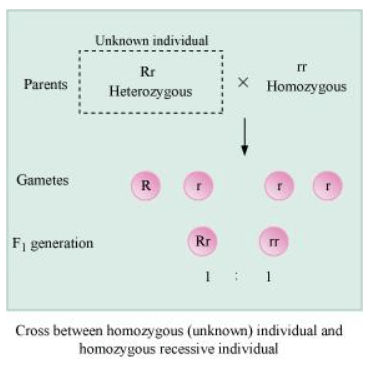
Question 6: Using a Punnett square, work out the distribution of phenotypic features in the first filial generation after a cross between a homozygous female and a heterozygous male for a single locus.
Solution. In guinea pigs, heterozygous male with black coat colour (Bb) is crossed with the female having white coat colour (bb). The male will produce two types of gametes, $\mathrm{B}$ and $\mathrm{b}$, while the female will produce only one kind of gamete, $\mathrm{r}$. The genotypic and phenotypic ratio in the progenies of $F_{1}$ generation will be same i.e., $1: 1$.
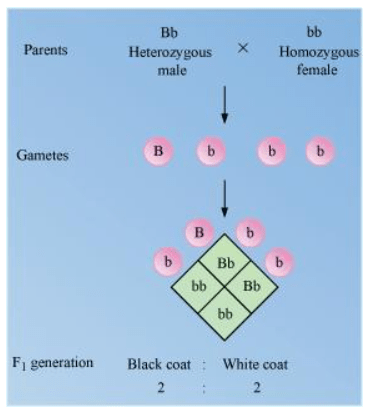
Question 7.When a cross in made between tall plants with yellow seeds (TtYy) and tall plant with green seed (TtYy), what proportions of phenotype in the offspring could be expected to be
(a) Tall and green.
(b) Dwarf and green.
Solution. A cross between tall plant with yellow seeds and tall plant with green seeds will produce
(a) three tall and green plants
(b) one dwarf and green plant

Question 8 Two heterozygous parents are crossed. If the two loci are linked what would be the distribution of phenotypic features in $\mathrm{F}_{1}$ generation for a dihybrid cross?
Solution. Linkage is defined as the coexistence of two or more genes in the same chromosome. If the genes are situated on the same chromosome and lie close to each other, then they are inherited together and are said to be linked genes.
For example, a cross between yellow body and white eyes and wild type parent in a Drosophila will produce wild type and yellow white progenies. It is because yellow bodied and white eyed genes are linked. Therefore, they are inherited together in progenies.
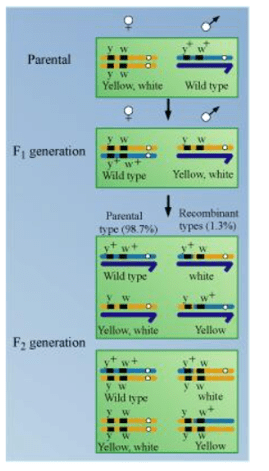
Question 9: Briefly mention the contribution of T.H. Morgan in genetics.
Solution. Morgan's work is based on fruit flies (Drosophila melanogaster). He formulated the chromosomal theory of linkage. He defined linkage as the co-existence of two or more genes in the same chromosome and performed dihybrid crosses in Drosophila to show that linked genes are inherited together and are located on X-chromosome. His experiments have also proved that tightly linked genes show very low recombination while loosely linked genes show higher recombination.
Question 10: What is pedigree analysis? Suggest how such an analysis, can be useful.
Solution. Pedigree analysis is a record of occurrence of a trait in several generations of a family. It is based on the fact that certain characteristic features are heritable in a family, for example, eye colour, skin colour, hair form and colour, and other facial characteristics. Along with these features, there are other genetic disorders such as Mendelian disorders that are inherited in a family, generation after generation. Hence, by using pedigree analysis for the study of specific traits or disorders, generation after generation, it is possible to trace the pattern of inheritance. In this analysis, the inheritance of a trait is represented as a tree, called family tree. Genetic counselors use pedigree chart for analysis of various traits and diseases in a family and predict their inheritance patterns. It is useful in preventing hemophilia, sickle cell anemia, and other genetic disorders in the future generations.
Question 11: How is sex determined in human beings?
Solution. Human beings exhibit male heterogamy. In humans, males (XY) produce two different types of gametes, $X$ and $Y$. The human female ( $X X$ ) produces only one type of gametes containing $X$ chromosomes. The sex of the baby is determined by the type of male gamete that fuses with the female gamete. If the fertilizing sperm contains $X$ chromosome, then the baby produced will be a girl and if the fertilizing sperm contains $Y$ chromosome, then the baby produced will be a boy. Hence, it is a matter of chance that determines the sex of a baby. There is an equal probability of the fertilizing sperm being an $X$ or $Y$ chromosome. Thus, it is the genetic make up of the sperm that determines the sex of the baby.

Question 12:A child has blood group O. If the father has blood group A and mother
blood group B, work out the genotypes of the parents and the possible genotypes of the other offsprings.
Solution. The blood group characteristic in humans is controlled by three set of alleles, namely, $I^{A}, I^{B}$, and i. The alleles, $I^{A}$ and $I^{B}$, are equally dominant whereas allele, i, is recessive to the other alleles. The individuals with genotype, $\mathrm{I}^{\mathrm{A}} \mathrm{I}^{\mathrm{A}}$ and $\mathrm{I}^{\mathrm{A}} \mathrm{i}$, have blood group A whereas the individuals with genotype, $\left.\left.\right|^{B}\right|^{B}$ and $I^{B}$ i, have blood group $B$. The persons with genotype $\left.\left.\right|^{A}\right|^{B}$ have blood group $A B$ while those with blood group $O$ have genotype ii
Hence, if the father has blood group A and mother has blood group B, then the possible genotype of the parents will be
Father Mother

A cross between homozygous parents will produce progeny with AB blood group.

A cross between heterozygous parents will produce progenies with AB blood group $\left(\mathrm{A}^{\mathrm{A}} \mathrm{B}^{\mathrm{B}}\right)$ and $\mathrm{O}$ blood group (ii)

Question 13: Explain the following terms with example
(a) Co-dominance
(b) Incomplete dominance
Solution. (a) Co-dominance
Co-dominance is the phenomenon in which both the alleles of a contrasting character are expressed in heterozygous condition. Both the alleles of a gene are equally dominant. ABO blood group in human beings is an example of co-dominance. The blood group character is controlled by three sets of alleles, namely, $\mathrm{I}^{A}, \mathrm{I}^{\mathrm{B}}$, and $\mathrm{i}$. The alleles, $\mathrm{I}^{\mathrm{A}}$ and $\mathrm{I}^{\mathrm{B}}$, are equally dominant and are said to be codominant as they are expressed in AB blood group. Both these alleles do not interfere with the expression of each other and produce their respective antigens. Hence, $A B$ blood group is an example of co-dominance.
2. Incomplete dominance
Incomplete dominance is a phenomenon in which one allele shows incomplete dominance over the other member of the allelic pair for a character. For example, a monohybrid cross between the plants having red flowers and white flowers in Antirrhinum species will result in all pink flower plants in $\mathrm{F}_{1}$ generation. The progeny obtained in $\mathrm{F}_{1}$ generation does not resemble either of the parents and exhibits intermediate characteristics. This is because the dominant allele, $R$, is partially dominant over the other allele, r. Therefore, the recessive allele, $r$, also gets expressed in the $F_{1}$ generation resulting in the production of intermediate pink flowering progenies with Rr genotype.

Question 14: What is point mutation? Give one example.
Solution. Point mutation is a change in a single base pair of DNA by substitution, deletion, or insertion of a single nitrogenous base. An example of point mutation is sickle cell anaemia. It involves mutation in a single base pair in the beta-globin chain of haemoglobin pigment of the blood. Glutamic acid in short arm of chromosome II gets replaced with valine at the sixth position.
Question 15: Who had proposed the chromosomal theory of inheritance?
Solution. Sutton and Boveri proposed the chromosomal theory of inheritance in 1902. They linked the inheritance of traits to the chromosomes.
Question 16: Mention any two autosomal genetic disorders with their symptoms.
Solution. Two autosomal genetic disorders are as follows.
1. Sickle cell Anaemia
It is an autosomal linked recessive disorder, which is caused by point mutation in the beta-globin chain of haemoglobin pigment of the blood. The disease is characterized by sickle shaped red blood cells, which are formed due to the mutant haemoglobin molecule. The disease is controlled by $\mathrm{Hb}^{\mathrm{A}}$ and $\mathrm{Hb}^{\mathrm{S}}$ allele. The homozygous individuals with genotype, $\mathrm{Hb}^{\mathrm{S}} \mathrm{Hb}^{\mathrm{S}}$, show the symptoms of this disease while the heterozygous individuals with genotype, $\mathrm{Hb}^{\mathrm{A}} \mathrm{Hb}^{\mathrm{S}}$, are not affected. However, they act as carriers of the disease.
Symptoms
Rapid heart rate, breathlessness, delayed growth and puberty, jaundice, weakness, fever, excessive thirst, chest pain, and decreased fertility are the major symptoms of sickle cell anaemia disease. (b) Down’s syndrome
It is an autosomal disorder that is caused by the trisomy of chromosome 21.
Symptoms
The individual is short statured with round head, open mouth, protruding tongue, short neck, slanting eyes, and broad short hands. The individual also shows retarded mental and physical growth.
Also Read,
Class 12 Chemistry Notes PDF.
Class 12 Biology Book Chapterwise PDF.
Class 12 Biology Exemplar Chapterwise PDF.
If you have any Confusion related to NCERT Solutions for Class 12 Biology Chapter 5 Principles of Inheritance and Variation PDF then feel free to ask in the comments section down below.
To watch Free Learning Videos on Class 12 Biology by Kota’s top Doctor Faculties Install the eSaral App
